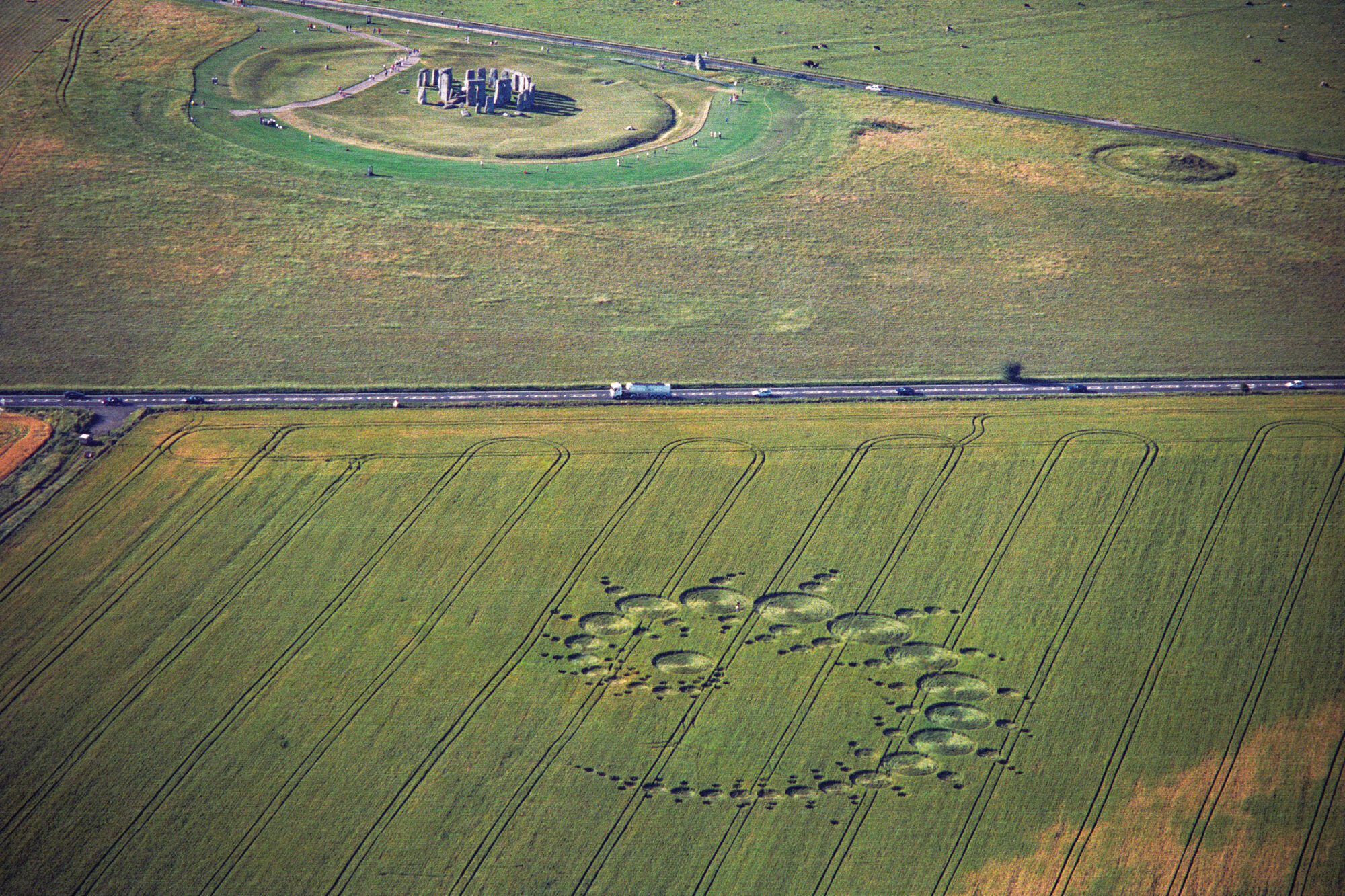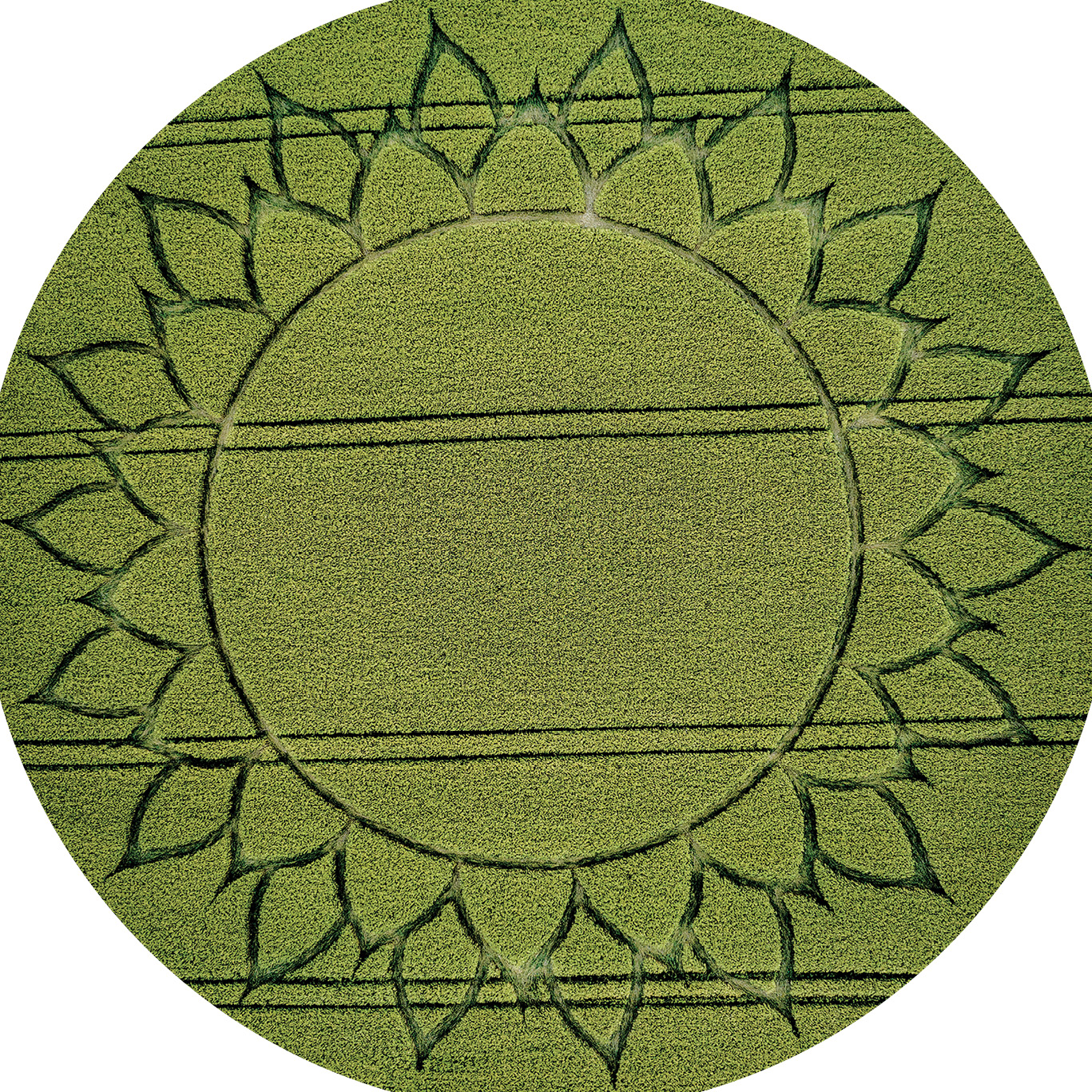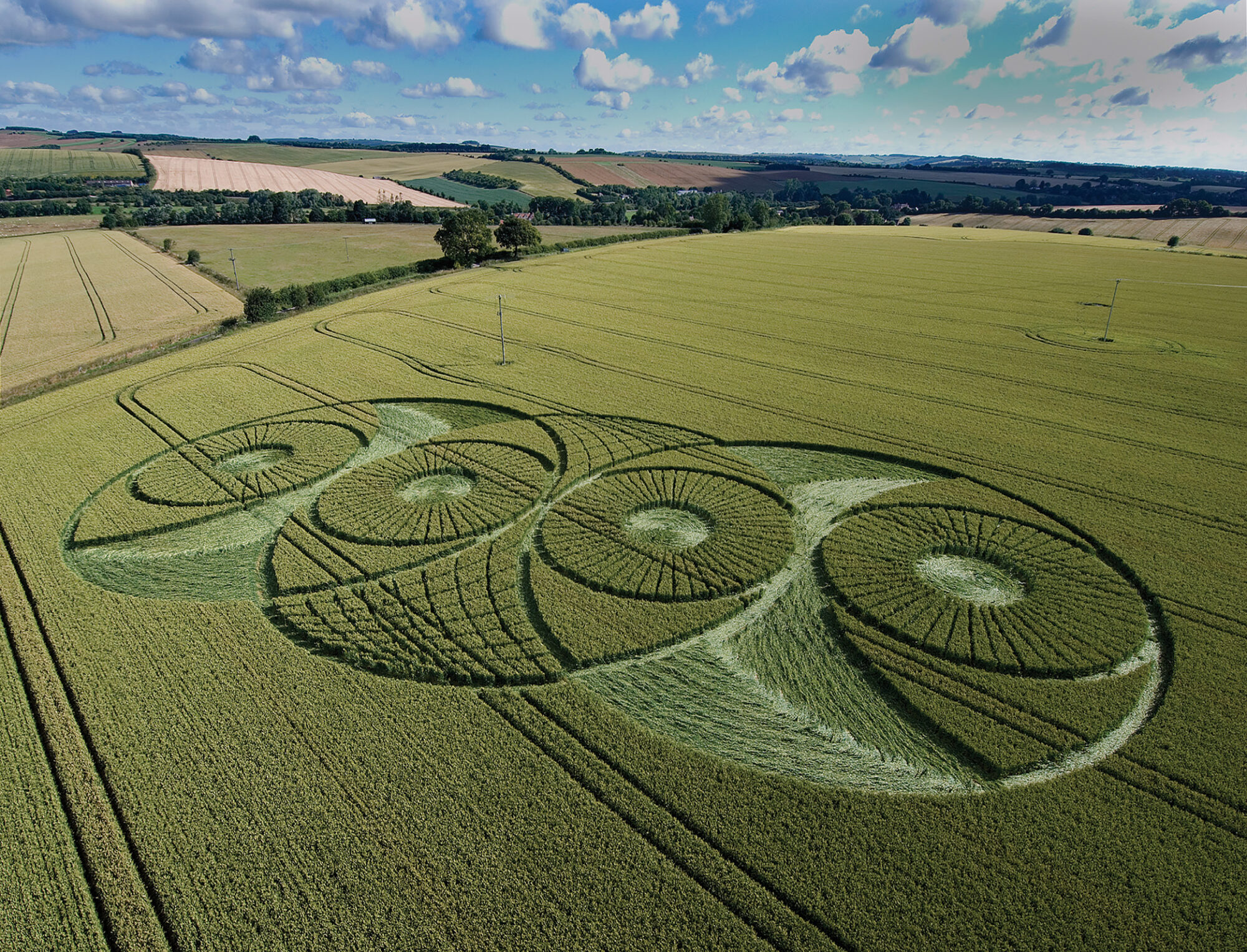I am interested in crop circles and believe them to be a perplexingly powerful phenomenon that demands serious investigation not because I am a woo woo tarot reader, or conspiracy theorist, or a person who has seen a UFO—though I am all these things—but because I am a land surveyor with a world view ineluctably shaped by hundreds of attempts over decades to precisely inscribe large and complex geometric shapes on the living land. For consider; whatever one’s theories about this decades-old (or perhaps centuries-old) land art, one must first grant that these sometimes vast and often strikingly lovely patterns in grain seem always to be designed, that is, their very existence is proof positive that some da Vinci-like mind inclined to both mathematics and aesthetics conceived of these intricate geometric patterns and audaciously decided to instantiate them physically in fields of ripening grain, like a sculptor working with ephemeral natural materials, or an artist making a canvas of barley or wheat, or even like an architect deciding to work in cereal crops for a change, rather than concrete and steel.

Potterne, Wilts, 7th June 2023 | Barley | OH Image copyright Steve Alexander
And when it comes to working with unusual architects, we land surveyors know a thing or two.
The Imaginary Client
My musings on crop circles sometimes take the form of an imaginary client who walks into my office and asks me if I could lay out a large pattern in a wheat field. “Sure,” I say, “I have the equipment and personnel to do that.” But then he says, “Well, FYI, the work has to be done all in one night. And you can’t just smash the wheat down—in fact, you have to carefully bend it an inch or so above the ground and weave it into a basket pattern. There will be people looking for you, but you can’t be seen and you can’t leave footprints. The pattern I want you to make is quite large, several hundred feet across, and it’s kind of complicated. Oh and, by the way, it’s not my field—and the farmer has threatened to shoot trespassers.”

Wiltshire | 7th July 1996. This famous “Stonehenge Julia Set” crop ‘circle’ (it’s actually hundreds of circles, arrayed along a spiral) appeared in 1996. Note the scale of the phenomenon, and proximity of the circle to a busy highway and megalithic site tourist attraction. Then think about how you’d lay out this huge complex pattern, secretly and overnight, if hired to do so. Image copyright Steve Alexander
So I show my imaginary client to the imaginary door in my mind, but I am left thinking—could I do such a thing?
Let’s review some of the oddities of crop circles, and what makes laying them out in fields of grain a difficult proposition:
- The imaginary farmer to whom my imaginary client alludes has a legitimate gripe—crop circles are actual vandalism, substantially reducing crop yields (and thus profits) and attracting nuisance tourism. Some farmers try to make the best of it by putting out collection boxes in afflicted fields, some try to keep trespassers out with new fences or early harvest, none encourage hoaxers or circle makers by invitation. Whatever lies behind the phenomenon, to field managers it is something like a costly infestation to be resisted and avoided if possible.
- The flattened crops that form the circles and geometric figures are not made by simply trampling down and breaking stalks. In fact, the grain stalks are carefully bent, not broken or snapped, an inch or two above original grade by some process that makes use of “node lengthening”—this much has been established by microscopic examination. Nor are the hundreds of square yards of grain simply laid down in efficient swathes; rather, they are often laid down in neat and beautiful weavings resembling basketwork or rushing water. A viable method for quickly replicating any of these features has never been demonstrated.
- Crop circles, including the largest and most complex, tend to appear overnight, sometimes in provably short time windows of a few hours. Their creation has never been filmed or witnessed and rarely seems to have been interrupted. That is, crop circles almost never appear that seem half-finished.
- It’s instructive to consider the circles as an art movement that has emerged over several decades, gradually evolving in complexity and size while retaining a recognizable aesthetic and mathematical underpinnings (based on sacred geometry, many say) that suggest a single creative mind. An artist (or artist’s collective) that chooses to work in the dark, in unpaid anonymity, using a difficult, impermanent medium. This is extraordinary; even the graffiti artist Banksy—the 21st century’s other great anonymous artist—finds a way to get paid, to the tune of around $20 million per year… and is not actually all that anonymous.
- Finally, the consistency and regularity of the phenomenon should be noted; in summer and early fall, for more than 40 years, dozens of crop circles have appeared in a small, densely farmed patch of southern England—the same region where notable ancient land art such as Stonehenge and the Uffington White Horse is found. This regular summer cycle, incidentally, seems not to have been affected by the 2020 Covid lockdowns; in fact, 2020 and 2021 were both pretty good years.
But not to be coy, the truth is that at least some formations are hoaxed, and by some very talented people. Working for pay and on commission, some hoaxers have made very large formations as advertisements or for TV programs. But all the large formations that have definitely been hoaxed were made in the daytime, on rented fields, by large crews using survey equipment, and with the help of large booms and drones so that the formation could be monitored from above during creation. And they tend to be visibly sloppy and clumsy, relative to the circles that appear mysteriously overnight. In terms American Surveyor readers might appreciate, it’s rather as if paid hoaxers are taking the credit for several remote and precisely set NGS benchmarks by saying they whanged them out overnight using nothing but a ball of string and a pair of binoculars.

Potterne, Wilts | 7th June 2023. The popular belief about circle creation is that small teams lay out simple shapes using measuring tapes and hand (or foot) tools—for example, a circle might be inscribed in grain by a man using a tape attached to a pivot point. But fairly often, as here, the radius point lies in undisturbed grain and there is no evidence of clumsy human involvement at all. Image copyright Steve Alexander
Credible debunking efforts have been aimed at the so called “Stonehenge Julia Set” crop circle, which appeared on Sunday, July 7, 1996, not far from Stonehenge and alongside the busy A303 highway. You can see why—it remains one of the most ornate crop circles ever to appear, with hundreds of discrete circles neatly arrayed across 600 feet of field, so prove this one was a hoax, and you’ve gone a long way towards discrediting the entire phenomenon… and vice versa of course.

Hillside Farm West Woods, Wiltshire | 20th July 2008. Considered solely as artistic creations, one has to acknowledge that the crop circles, typically appearing in remote rural settings, are often lovely, impressive, solitary, and inexplicably eerie. Image copyright Steve Alexander
Writing in the May/June 2022 Skeptical Inquirer, Benjamin Radford first examines the evidence that the giant pattern appeared in just a 45-minute time window, as described by a pilot that flew out and back over the field that evening and other witnesses including the actual farmer and succeeds only to the extent that he plausibly expands the time window from 45 minutes to overnight. It remains certain that no team of artsy vandals was out in the field trampling down grain the day before the formation appeared, as they would have been spotted by at least a few of the thousands of Stonehenge visitors and/or passing A303 motorists.
To get around this awkward truth, Radford then introduces one “Rod Dickinson,” who claims to know the team of three that made the circle “in about two and three-quarters hours, starting around 2:45 am.” Dickinson is helpful enough to describe the layout method:
You start with the large central circle, which is placed right next to a tram line. People asked why it had the large central circle, which is a little out of place in a Julia Set. Simple. To avoid damaging surrounding crop, you have to have a large central area already layed [sic] down, from which you can measure out diameters to other parts of the formation. After making the first circle, they measured out a work line for the rest of the formation.

Etchilhampton Hill, Wiltshire | 25th July 2011. Those who maintain that crop circles are unsophisticated hoaxes say that the patterns are mashed down quickly with simple hand tools. But often, as here, the bent grain is formed into complex basket weaving and flowing imprints. Note also that the ‘circles’ are often composed of straight lines, not so easy to layout as circles inscribed around a radius point. Image copyright Steve Alexander
Where to begin? Surveyors might first note how much work the phrase “measured out a work line” is doing here, and think about how they might go about using a tape to lay out a spiral and 150 radius points, and then they might consider the difficulties of precisely flattening out 150 circles of varying diameters up to 40 feet. All on a dark damp night with a crew of three, while not touching any extraneous grain and leaving no boot prints, working at a rate of about one minute per circle.
I’m just gonna say it—Rod Dickinson is not credible.
I’m Not Saying It’s Aliens, But…
I am, in fact, not saying it’s aliens. To me, the multi-decade crop circle enigma has more in common with Marian apparitions, fairy lore, or megalithic construction—all of these are widely witnessed and much studied and documented, and all exhibit varying forms of technological prowess that is not understood. Nor is creation by human agency actually impossible. In a world containing such expensive and secretive marvels as the High-frequency Active Auroral Research Program (HAARP), or whatever wizardry has replaced the SR-71 Blackbird, room can be surely posited for, say, a well-funded group of zany artistes making use of directed microwaves or sonic micro-booms, or… some other eerie unknown science. And my own pet theory is that the weirdly beautiful, yet somehow familiar patterns are the daydreams and doodles of Gaia, inscribed in verdant fields of grain to awe and amuse we silly puffed-up primates.

But in any case, wouldn’t it be nice to know a bit more about the means of creation and the motives of the mysterious makers? Maybe some decent as-built surveying is in order, or the deployment of sophisticated remote sensing technology? Isn’t study of the liminal processes of the Nature a natural and proper activity for Man?
LOL, just kidding, it’s totally aliens. And the crop circle tattoo on my left forearm will surely win me a position of oversight in the post-alien-takeover world soon to come.
Angus Stocking is a former licensed land surveyor and infrastructure writer since 2001 who has been intrigued by crop circles his entire adult life. Which is totally normal, shut up.